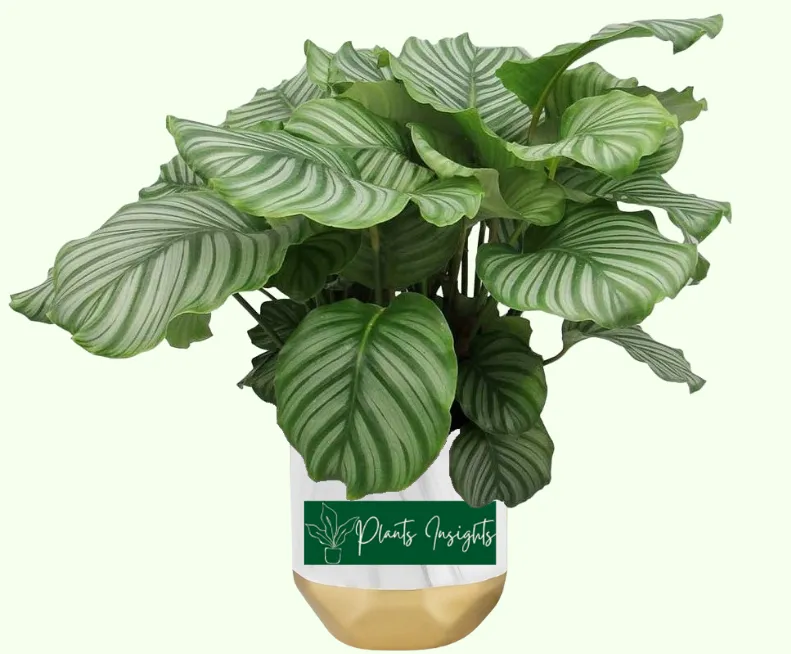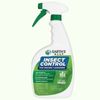The Calathea Orbifolia or Round Leaf Calathea is a beautiful but challenging plant to take care of. It has large round leaves with silver-colored stripes. The plant is so appealing and plant admirers cannot resist buying this bounty. Keeping the Calathea Orbifolia looking radiant, however, comes at an effort as it is not as easygoing as some of its other family members.
The silver-green leaves of this plant grow in a fan configuration and can quickly become large. The leaves are glossy and can be up to 30 cm wide. To maintain their optimal health, provide the plants with plenty of room to expand, adequate moisture, and indirect sunlight. Calathea Orbifolia when grown indoors normally gets up to 2 feet tall, however, in some cases, it can achieve more height.
Prominent Family Members: Calathea Medallion, Calathea Zebrina, Calathea Lancifolia, Calathea Yellow Fusion, Calathea Ornata, Calathea Louisae, Calathea Musaica
Essential Products
Calathea Orbifolia Care Guide
The best practices for growing Calathea Orbifolia would be to hydrate the plant just enough so that soil remains slightly moist, keep in bright indirect light and provide it with the right climatic conditions of temperature and humidity.
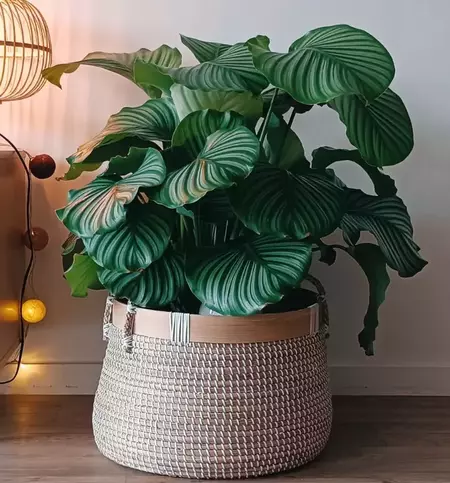
In this care guide, we will discuss all the points in detail so that we can enjoy the presence of flourishing and radiating Calathea Orbifolia in our homes.

Bringing Orbifolia to your Home
Planting a new Round Leaf Calathea in your home is an exciting decision, but it’s important to take proper precautions. We recommend that you thoroughly inspect the plant before bringing them into any area of concern, even if the plant seems healthy.
If the precautionary measures are not followed, any native infestations in your new plant can spread to your other houseplants. We recommend waiting for at least two weeks before treating your new Calathea normally.
Once the quarantine period is over, bring out the plant to the location receiving indirect medium sunlight.


How often should I water my Calathea Orbifolia?
You should develop a watering schedule for your Calathea Orbifolia that helps it thrive and then follow the schedule rigorously to prevent any potential problems. Round Leaf Calatheas are susceptible to sickness because of long periods of dehydration, which can cause them to establish brown leaves, while overwatering will trigger wilt and yellow leaves. Inadequate watering degrades the plant’s general health and reduces the plant’s capability to recuperate properly from diseases and infections.
While Calatheas love for moisture is well-known, novice gardeners can easily overdo it. This leads to leaves yellowing and root rot issues, among other things. To avoid these unfortunate consequences, make sure that your soil has dried out before giving them another dose of water.
The best practice is to always check the soil moisture level before re-watering. Whenever you are planning to water the Orbifolia Calathea ensure that the top one-inch layer of soil has dried.
To keep your Calathea healthy and thriving, you must vary the frequency at which they are watered, matching with the climatic changes. This means as the temperatures decrease in winter, you should also reduce the water input to the plant accordingly.
Another aspect that can hurt the health of Calathea Orbifolia is because it is fed mineral-rich tap water. It can have a more adverse effect on plant health if your tap water is rich in minerals. To reduce this risk, we recommend using distilled or rainwater for watering your plants and ensuring that water is always kept at room temperature before watering.

Does Calathea Orbifolia need sunlight?
This plant needs to grow in medium-low light, away from direct sunlight. If the lighting is too bright, the leaves will start fading, and extended exposure may result in the dying of leaves.
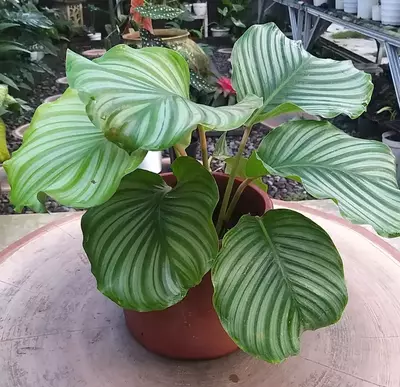
We recommend keeping Calathea Orbifolia away from direct sunlight. Contrary to its other family members like Calathea Medallion and Ornata who grow well in bright light, Orbifolia loves to live in low to medium light.
Sometimes it is not easing for people to pinpoint the reason for plants’ health deterioration. If you notice the strips on your Calathea’s leaves are diminishing, it might be getting too much sunlight. Move the plant to a shadier place, and it will happily reward you with those exotic striped leaves.

Humidity and Temperature
Calathea Orbifolia originates from Tropical America, and it loves warm and humid climates. The perfect temperature for this beauty is 65 – 75 °F. The large, round leaves of Orbifolia react relatively quickly to temperature changes.
If you notice that leaves are curling up, it is an indication of too much heat for the plant, whereas a reduction in temperature will cause drooping of the leaves.
As the suggested temperature range of 65 – 75 °F, Orbifolia can be grown outdoors in a shaded space, if the temperature does not reduce to 60 °F. However, if the temperature goes down from 60 °F, bring your plant inside.
These charming Calathea plants originally belong to tropical habitats. Like its family members Calathea White Fusion and Warscewiczii, it needs high humidity, usually averaging 50% or more, to grow happily. If your home doesn’t have much humidity inside, use a plant humidifier matching the requirement to keep the plant happy.

Orbifolia Plant Soil Requirements
Calathea Orbifolia loves moist soil. To keep your Orbifolia healthy and happy, the soil must be moist but not soggy. A good bet would be a potting soil mixed with sand or perlite and organic matter like orchid bark.
Organic matter will provide the necessary nutrients to plant, potting soil will help in retaining moisture whereas perlite will add the well-draining characteristic to the soil mix.
You can purchase Calathea specific soil from your garden store or online, however, if you are not able to find the soil explicitly made for Calatheas, African Violet mix is the best match for Calatheas.

Fertilizer for Geoppertia Calathea
Plants in the Calathea family do not require frequent feeding. During the growing season of Calathea Orbifolia which is spring and summer, occasional fertilizing will boost the growth and enhance the color of foliage. Do not overfeed the Orbifolia, as the delicate roots of the plant can get damaged because of overfeeding.
Dark Green Foliage after Fertilizing
A diluted balanced houseplant fertilizer shall be used for feeding Orbifolia. Please note to dilute the fertilizer to a quarter of its strength and feed the plant on a monthly basis during the growing season.

When should I repot my Calathea Orbifolia?
Calathea Orbifolia shall not be repotted frequently. Normally it should be repotted after two years. Orbifolia does not like to be repotted, however, its growth becomes stunted if roots are bound. Therefore, repotting is a necessity once your pot size has become insufficient to accommodate the roots.
Please follow the following simple steps to carry out the repotting.

Propagation
Propagating Calathea Orbifolia is a formidable job. Like other family members of Rufibarba and Zebrina, it is also not successfully propagated by seeds or cuttings. The most successful propagation technique for Calathea Orbifolia is a division from the roots (rhizomes).

The best time for Orbifolia propagation is to carryout it along with repotting. Orbifolia rots do not like to be disturbed and if propagation is not handled carefully the plant’s life is endangered.
Please carry out the following steps additional to repotting for propagating Calathea Orbifolia.

Cleaning and Maintenance
Orbifolia has single-stemmed leaves and does not require frequent pruning However to improve their appearance, it is necessary to remove yellow or dying leaves.
Calathea Orbifolia has large, glossy leaves, and wiping them with a wet cloth will remove settled dust and rejuvenate their glow. An occasional shower will also boost the plant’s look and health. We recommend flushing the Orbifolia soil before the start of winter.
Flushing of soil will take away accumulated minerals from the soil. To flush the plant, place the plant underwater flow for 2-3 minutes. Once the soil is flushed, drain the water completely and let the soil dry before the next watering cycle.

Toxicity of Orbifolia
Calathea plants are not toxic to humans and pets, so they make a perfect choice for a houseplant. However, Calathea Orbifolia leaves are attractive to pets, and they may try to chew on them.
Excessive consumption of leaves can be dangerous to pets and plants, despite being non-toxic. Therefore, please take care of such a scenario by watching out when small children or pets are around the plant.

Common Problems
Pests
Calathea Orbifolia plants favor humid and damp climates, which can make them more susceptible to pest attacks and fungal diseases. The most common pests that attack Orbifolia are mites, mealybugs, thrips, and aphids. Please have regular close inspections of your plants to identify infestations at the earliest stage.
If you observe any pests on the plant, carry out the cleaning of the plant to remove the infestation manually. Wipe the leaves with a wet cloth, treat them with neem oil to prevent the infestation. Insecticides can also be used if the infestation becomes out of control.
Leaves brown edges and Yellowing
If you’re noticing yellowing leaves on your Calathea Orbifolia , It is a sign that the watering is not appropriate. Yellowing of leaves is usually indicated to overwatering. To fix this concern, please review your watering schedule. Always ensure not to water the plant if the topsoil is wet.
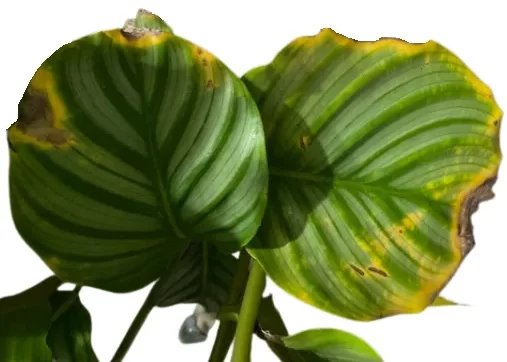
Brown Edges and Yellowing of Leaves
Leaves Curling
Leaves curling happens if Orbifolia is exposed to increased temperatures or high heat. Leaf curling is a defense mechanism nature has imparted in these plants. In case of exposure to high heat, the leaves curl up to avoid further loss of moisture from the plant.
Leaves Drooping
Lower humidity levels can cause the leaves to droop. Provide the Orbifolia with optimum humidity levels to solve the issue.
Cold drafts and exposure to lower temperatures will also result in drooping of leaves. If you are growing your Orbifolia outdoors, bring it inside once night temperatures become lower than 60 °F.

Leaves Drooping
Leaves Wilting after repotting
Calathea Orbifolia gets stressed when it is relocated from one pot to another. It’s common for leaves to wilt and drop, but the best way of caring for these anxious houseplants is by simply placing them in a bright place with high humidity after repotting. Please avoid fertilizing or pruning until you see improvement.
Not blooming
Calathea Orbifolia in its native areas often blooms and produces subtle white flora on its stems. It is very rare to see Orbifolia blooming indoors. After all, it is the adorable large and glossy foliage to which plant owners are attracted. Therefore, do not worry if your Orbifolia is not blooming, as it is not expected to bloom indoors.

Is Calathea Orbifolia hard to care for?
Taking care of Calathea Orbifolia can be a test for houseplant owners. It’s essential to keep them in a warm, humid environment depicting their natural surroundings. However, if your Orbifolia has some troubles, read on to our detailed guide to diagnose and fix the issue.
Is Calathea Orbifolia fast growing?
Calathea Orbifolia has a moderate growth rate. Under the ideal conditions of moderate indirect light and optimum soil moisture levels, Orbifolia Calathea can reach a height of two feet in around 02 years. In some cases, Orbifolia gets tall up to 2.5 Feet.
Why is my Calathea Orbifolia dying?
Calathea Orbifolia’s health can degrade because of numerous causes. Initially, look for the symptoms for the proper diagnosis of the trouble. If your Orbifolia leaves have extreme yellowing most possible reason is over-watering. Decrease the plant watering frequency and water just when the soil has partly dried.
Please ensure to unblock the water drain opening in the pot. If the yellowing of leaves is much more noticeable near the plant’s bottom, root rot can be the root cause of the problem.
The absence of adequate humidity can cause browning on the edges of the leaves. If you notice browning on the edges, raise your indoor humidity level to resolve the concern or position the plant in a more humid place like a washroom.
Excessive sunlight can damage the leaves and is evident in terms of stains or discoloration on leaves midspan.

